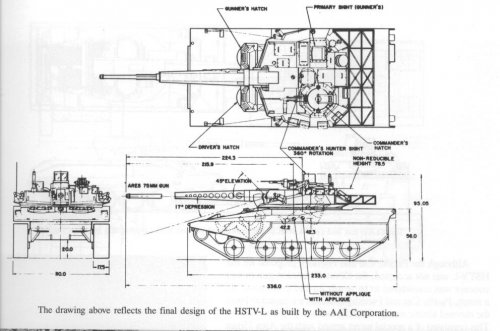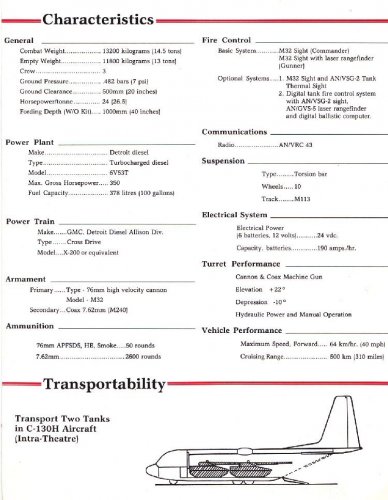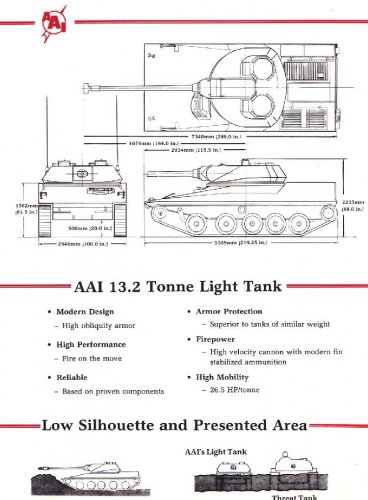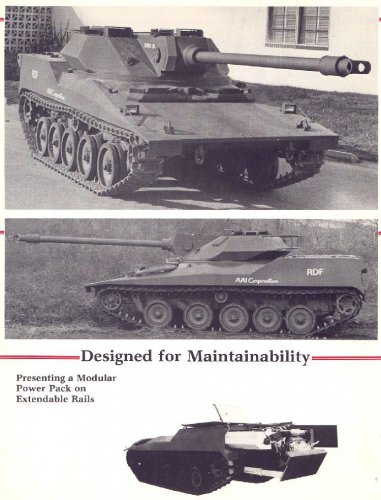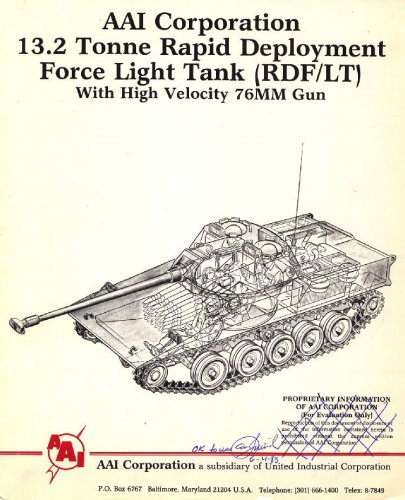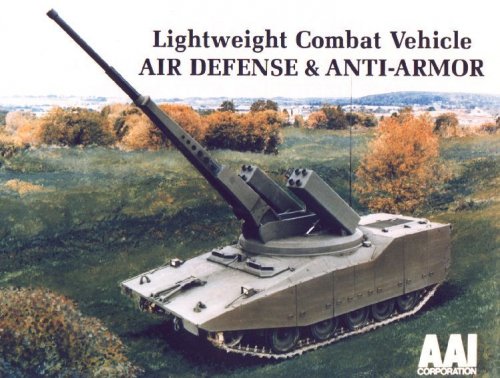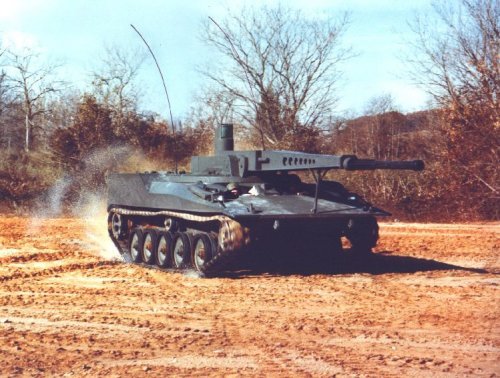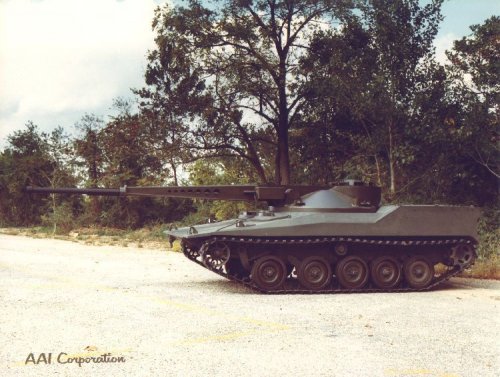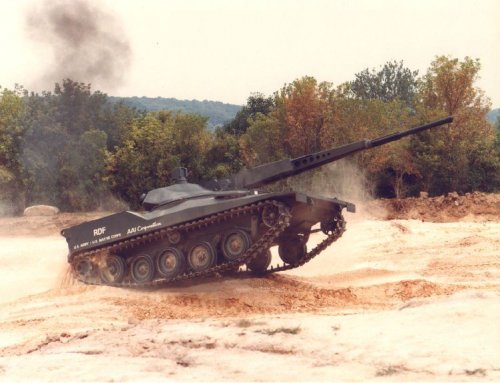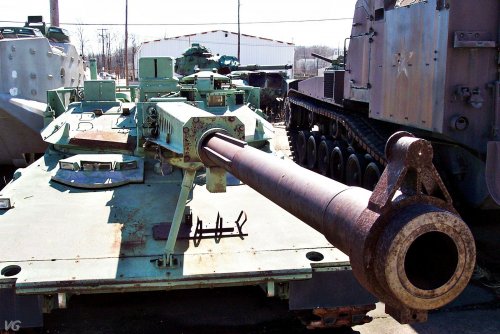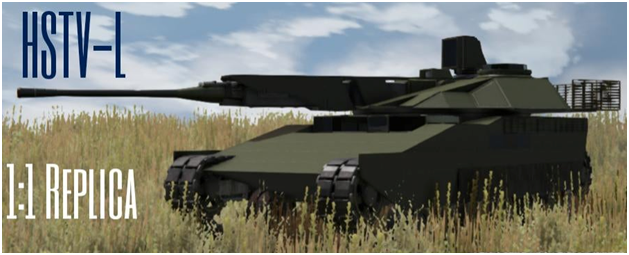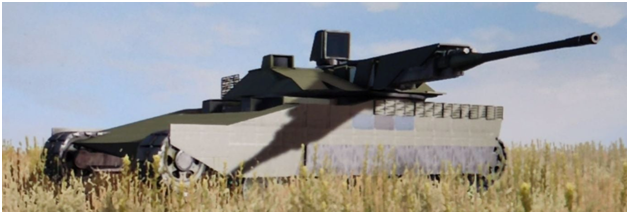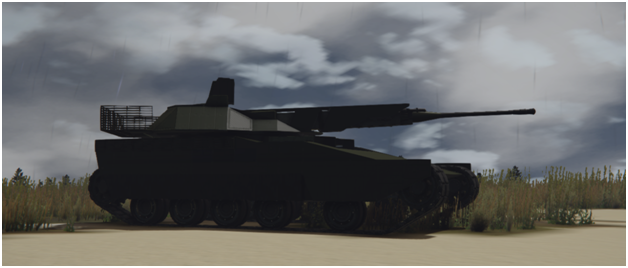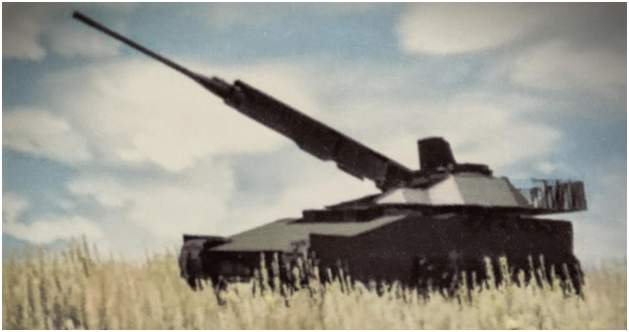You are using an out of date browser. It may not display this or other websites correctly.
You should upgrade or use an alternative browser.
You should upgrade or use an alternative browser.
Rapid Deployment Force Light Tank by AAI Corp?
- Thread starter arc3371
- Start date
There was a very extensive article on this one in frenc magazine RAID " Hors Serie" that focussed on light tanks. Apparently, it was supposed to kill heavier tanks by hitting them with a 3 shell burst in the same spot. Callibre was 75mm.
Interresting design.
Interresting design.
- Joined
- 21 May 2006
- Messages
- 3,002
- Reaction score
- 2,278
I read somewhere, many years ago that this Light Tank, also had some anti-helicopter capability with its 75mm gun and turret elevation!
Can anyone confirm this?
I think the US Army really lacks this capability of Rapid Deployment type tank!
Regards
Pioneer
Can anyone confirm this?
I think the US Army really lacks this capability of Rapid Deployment type tank!
Regards
Pioneer
Sentinel Chicken
American 71 Heavy, contact departure 126.47
Isn't that what the Stryker is for?Pioneer said:I read somewhere, many years ago that this Light Tank, also had some anti-helicopter capability with its 75mm gun and turret elevation!
Can anyone confirm this?
I think the US Army really lacks this capability of Rapid Deployment type tank!
Regards
Pioneer
Firefly said:There was a very extensive article on this one in frenc magazine RAID " Hors Serie" that focussed on light tanks. Apparently, it was supposed to kill heavier tanks by hitting them with a 3 shell burst in the same spot. Callibre was 75mm.
Interresting design.
Firefly,
Could you tell the issue which the aforesaid article appeared in? Appreciation and thanks.
SmithW6079
ACCESS: Restricted
- Joined
- 8 May 2007
- Messages
- 24
- Reaction score
- 4
I don't have any 3-views for you, but the JED website has some great pictures of various versions of the RDF tank including:
-the original two-man vehicle with unmanned turret
-the two-man turret version shown by smurf
-an export version armed with a 76mm gun
-a SPAAG version armed with the 75mm gun and Stinger rocket pods
The JED website material is copyrighted so rather than risk anyone's wrath by posting the photos, I'll post the link instead. Enjoy!
http://www.jedsite.info/tanks-romeo/romeo/rdf_series/rdf-series.html
-the original two-man vehicle with unmanned turret
-the two-man turret version shown by smurf
-an export version armed with a 76mm gun
-a SPAAG version armed with the 75mm gun and Stinger rocket pods
The JED website material is copyrighted so rather than risk anyone's wrath by posting the photos, I'll post the link instead. Enjoy!
http://www.jedsite.info/tanks-romeo/romeo/rdf_series/rdf-series.html
A
AGRA
Guest
Pioneer said:I read somewhere, many years ago that this Light Tank, also had some anti-helicopter capability with its 75mm gun and turret elevation!
The key element of the RDF/LT GBAD capability was the use of the same IR prox fuses on naval Oto gun 76mm for the 75mm ARES gun. With a 60 rpm rate of fire this would make it a very lethal 3-4 rounds burst GBAD.
Of course it would lake an air search and track sensor so GBAD fires would be only after visual identification of the air threat. Still its a lot better than a roof mounted 12.7mm/7.62mm. Especially for engaging attack helos with standoff anti tank missiles.
jackehammond
ACCESS: Restricted
- Joined
- 17 September 2007
- Messages
- 18
- Reaction score
- 5
[edited to attach pictures through forum. Thanks Jack]
Attachments
8)
Great posts, especially Jackhammond -- the AAI brochure is a treasure! Alos: you ight want to check Jane's Armor and Artillery yearbooks for the late 1980s and early 1990s -- they had extensive write ups of all of AAI's products as well as some of the competing designs from FMC (i.e., the CCVL -- close combat vehicle Light, that morphed into the M-8 Armored Gun System).
BTW does anyone know if the RDFLT was actually tested abroad?
Great posts, especially Jackhammond -- the AAI brochure is a treasure! Alos: you ight want to check Jane's Armor and Artillery yearbooks for the late 1980s and early 1990s -- they had extensive write ups of all of AAI's products as well as some of the competing designs from FMC (i.e., the CCVL -- close combat vehicle Light, that morphed into the M-8 Armored Gun System).
BTW does anyone know if the RDFLT was actually tested abroad?
- Joined
- 18 March 2008
- Messages
- 3,529
- Reaction score
- 978
Here is some more on the vehicles associated with the RDF/LT. The following information has been copied from Jane’s Light Tanks and Armoured Cars 1984 by Christopher F. Foss. It is posted here for educational purposes:
High Survivability Test Vehicle (Lightweight)
Development
The High Survivability Test Vehicle – Lightweight (HSTV-L) was developed under the direction of the TACOM project manager for Armored Combat Vehicle Technology at the US Army Tank-Automotive Command, Warren, Michigan.
Following the field testing, the HSTV(L) is being used for experiments in fire-control and stabilisation. Stabilisation processing has been converted from analogue to digital. Various stabilization control algorithms are being tried along with different combinations of transducers to determine effects on gun pointing performance and the possibility of eliminating some of the expensive sensors such as gyros. The TACOM Motion Base Simulator, a huge shaker table, is being used to provide terrain input. These tests began in September 1982 and are to continue for a year or more.
Description
The high survivability of this vehicle is derived from the low silhouette, high horsepower per ton, duplication of sights, improved night vision capabilities, and the lack of specific driver and gunner controls. Any crewman can shoot and both hull crewmen can drive.
Although a test vehicle, the HSTV(L) is not a variable parameter test bed but an exercise in system realism for the three-man crew, hunter/killer fire control concept and low silhouette.
Armament for the HSTV(L) consists of a 7.62 mm M240 machine gun for both commander and coaxial position and a 75 mm smooth bore cannon. The cannon employs a revolving breech and telescoping ammunition which enables the automatic loader to load one round per 11/2 seconds. The in battery-firing recoil mechanism has a fixed piston that allows the greater mass of recoil cylinder and breech mechanism parts to recoil during firing. The 75 mm gun and automatic ammunition feeder are designed and made by ARES Inc, Port Clinton, Ohio.
Texas Instruments supplies the fire-control system which uses the hunter/killer concept. The commander uses a stabilised hunter sight that revolves independently of the turret. Once a target is selected on this sight, the turret and killer sight can be aligned with it. The gunner can then destroy the selected target while the commander returns to search with his hunter sight. Both direct vision and FLIR (Forward Looking Infra-red) optics are available for either sight. The commander can use either a binocular direct view optic eyepiece for improved clarity and reduced power drain, or a video screen. In the hull, a video screen visible to both gunner and driver receives transmissions from hunter and killer sights.
The electronic fire control processor uses inputs from the sights, crosswind sensor, muzzle reference, vertical reference system, and an eye-safe CO2 laser rangefinder to compute proper gun pointing. The laser rangefinder is supplied by Raytheon. Automatic tracking and rate aid tracking can also be accomplished by the fire control processor.
Both elevation and azimuth stabilisation is provided for the 75 mm gun with a slaved killer sight and an indepen¬dently stabilised hunter sight. Fire-on-the-move capabilities are improved by decoupling the yaw motion of the hull from the turret. Cadillac Gage supplies the gun control and stabilisation system for HSTV(L).
Propulsion for the HSTV(L) comes from a gas turbine engine mounted beside the transmission with a cross-drive gearbox connecting the two. Avco Lycoming supplies the nonregenerative 650 horsepower modified helicopter gas turbine. The transmission is an X-300 Detroit Diesel Allison automatic four-speed with lock-up torque converter. Auxili¬ary power is provided by two 250 amp generators and a 60 gpm hydraulic pump. The hydraulic pump supplies power for the engine compartment mounted oil cooler fan and through a hydraulic slip ring; it also supplies power to the gun control system and automatic ammunition loader in the turret.
Teledyne supply the fixed height hydro-pneumatic sus¬pension system. A 355.6 mm jounce and 127 mm rebound travel is possible due to the small 558.8 mm diameter road wheels. The track is an improved version of the type found on the M551 Sheridan.
The man-machine interface for the HSTV(L) is of prime importance. The use of the hunter/killer concept allows both the gunner and the commander to contribute as much information as possible towards the neutralisation of the enemy. The use of pressure sensitive isometric rate controller thumb switches allows for more precise gun control while firing on the move. The driver and gunner seating positions are semi-reclined for maximum comfort in a minimum space. The tv screens considerably improve fire-on-the-move sighting clarity.
SPECIFICATIONS
CREW 3
TEST VEHICLE WEIGHT (with instrumentation and partial applique armour) 20 450 kg
POWER-TO-WEIGHT RATIO 31 78 hp/tonne
GROUND PRESSURE 0.7 kg/cm2
LENGTH GUN FORWARDS 8.528 m
LENGTH HULL 5 918 m
WIDTH 2.794 m
HEIGHT (overall) 2.414 m (to turret top) 1.994 m (to hull top) 1.422 m
GROUND CLEARANCE 0.508 m
TRACK 2.349 m
TRACK WIDTH 445 mm
MAX SPEED (road) 83.68 km/h
ACCELERATION (0 to 48 km/h) 11.8 sec
FUEL CAPACITY 409 litres
MAX CRUISING RANGE 160 km
FORDING 1.0 m
GRADIENT 60%
SIDE SLOPE 30%
TURNING RADIUS pivot to infinity
ENGINE Avco-Lycoming 650 turboshaft developing 650hp
TRANSMISSION GMC Detroit Diesel Allison Division cross drive model X-300-4A with 4 forward and 1 reverse gears, single-stage, multiple-phase torque converter with automatic lock up
STEERING hydrostatically controlled differential, pivot steer in neutral
BRAKES multiple wet plate, service and parking, hydrostatically applied with mechanical backup
SUSPENSION hydro-pneumatic
ELECTRICAL SYSTEM 24 V
BATTERIES 6 × 12 V, 300 Ah
ARMAMENT (main) 1 × 75 mm (coaxial) 1 × 7.62 mm MG (anti-aircraft) 1 × 7.62 mm MG
AMMUNITION (main) 26 (MG) 3200
FIRE-CONTROL SYSTEM powered/manual
By commander yes
By gunner yes
Gun elevation/ depression +45°/-17° front, +45°/-6° rear, +45°/-30° side
Max rate (power) elevation/depression 1.0 rad/sec
Max rate (manual) elevation/depression 10 mils/crank
Min rate (power) elevation/depression 0.2 mils/sec
Max traverse rate (power) 1.0 rad/sec
Max traverse rate (manual) 10 mils/crank
Min traverse rate (power) 0.2 mils/sec
Periscopes driver 3 (×1), gunner 3 (×1), commander 8 (×1)
Primary engagement sight (turret) stabilised head, FLIR CO2 laser rangefinder, tv, 2 FOV linked to all three crew members
Hunter sight (turret) stabilised head, rotates independently of turret; FLIR; direct view optics, tv, 2 FOV linked to all three crew members
Gunner’s sight (hull) slaved to weapon, direct view optics, 2 FOV gunner’s use only
Status: Undergoing stabilisation/fire control testing on the Motion Base Simulator, Tank Automotive Command, Warren, Michigan.
Manufacturer: AAI Corporation, Box 6767, Baltimore. Maryland 21204, USA.
http://i76.photobucket.com/albums/j35/abegubler/hstv01.jpg
http://i76.photobucket.com/albums/j35/abegubler/hstv02.jpg
HSTV(L) undergoing stabilisation/fire-control testing on Motion Base Simulator, TACOM, Warren, Michigan (US Army)
http://i76.photobucket.com/albums/j35/abegubler/hstv03.jpg
Above: Typical target engagement by HSTV(L)
http://i76.photobucket.com/albums/j35/abegubler/hstv04.jpg
HSTV(L) with all hatches closed and armoured track skirts fitted
http://i76.photobucket.com/albums/j35/abegubler/hstv05.jpg
Cutaway drawing of HSTV(L) showing position of main components of Texas Instruments fire-control system
http://i76.photobucket.com/albums/j35/abegubler/hstv06.jpg
Three-view drawing of HSTV(L)
High Survivability Test Vehicle (Lightweight)
Development
The High Survivability Test Vehicle – Lightweight (HSTV-L) was developed under the direction of the TACOM project manager for Armored Combat Vehicle Technology at the US Army Tank-Automotive Command, Warren, Michigan.
Following the field testing, the HSTV(L) is being used for experiments in fire-control and stabilisation. Stabilisation processing has been converted from analogue to digital. Various stabilization control algorithms are being tried along with different combinations of transducers to determine effects on gun pointing performance and the possibility of eliminating some of the expensive sensors such as gyros. The TACOM Motion Base Simulator, a huge shaker table, is being used to provide terrain input. These tests began in September 1982 and are to continue for a year or more.
Description
The high survivability of this vehicle is derived from the low silhouette, high horsepower per ton, duplication of sights, improved night vision capabilities, and the lack of specific driver and gunner controls. Any crewman can shoot and both hull crewmen can drive.
Although a test vehicle, the HSTV(L) is not a variable parameter test bed but an exercise in system realism for the three-man crew, hunter/killer fire control concept and low silhouette.
Armament for the HSTV(L) consists of a 7.62 mm M240 machine gun for both commander and coaxial position and a 75 mm smooth bore cannon. The cannon employs a revolving breech and telescoping ammunition which enables the automatic loader to load one round per 11/2 seconds. The in battery-firing recoil mechanism has a fixed piston that allows the greater mass of recoil cylinder and breech mechanism parts to recoil during firing. The 75 mm gun and automatic ammunition feeder are designed and made by ARES Inc, Port Clinton, Ohio.
Texas Instruments supplies the fire-control system which uses the hunter/killer concept. The commander uses a stabilised hunter sight that revolves independently of the turret. Once a target is selected on this sight, the turret and killer sight can be aligned with it. The gunner can then destroy the selected target while the commander returns to search with his hunter sight. Both direct vision and FLIR (Forward Looking Infra-red) optics are available for either sight. The commander can use either a binocular direct view optic eyepiece for improved clarity and reduced power drain, or a video screen. In the hull, a video screen visible to both gunner and driver receives transmissions from hunter and killer sights.
The electronic fire control processor uses inputs from the sights, crosswind sensor, muzzle reference, vertical reference system, and an eye-safe CO2 laser rangefinder to compute proper gun pointing. The laser rangefinder is supplied by Raytheon. Automatic tracking and rate aid tracking can also be accomplished by the fire control processor.
Both elevation and azimuth stabilisation is provided for the 75 mm gun with a slaved killer sight and an indepen¬dently stabilised hunter sight. Fire-on-the-move capabilities are improved by decoupling the yaw motion of the hull from the turret. Cadillac Gage supplies the gun control and stabilisation system for HSTV(L).
Propulsion for the HSTV(L) comes from a gas turbine engine mounted beside the transmission with a cross-drive gearbox connecting the two. Avco Lycoming supplies the nonregenerative 650 horsepower modified helicopter gas turbine. The transmission is an X-300 Detroit Diesel Allison automatic four-speed with lock-up torque converter. Auxili¬ary power is provided by two 250 amp generators and a 60 gpm hydraulic pump. The hydraulic pump supplies power for the engine compartment mounted oil cooler fan and through a hydraulic slip ring; it also supplies power to the gun control system and automatic ammunition loader in the turret.
Teledyne supply the fixed height hydro-pneumatic sus¬pension system. A 355.6 mm jounce and 127 mm rebound travel is possible due to the small 558.8 mm diameter road wheels. The track is an improved version of the type found on the M551 Sheridan.
The man-machine interface for the HSTV(L) is of prime importance. The use of the hunter/killer concept allows both the gunner and the commander to contribute as much information as possible towards the neutralisation of the enemy. The use of pressure sensitive isometric rate controller thumb switches allows for more precise gun control while firing on the move. The driver and gunner seating positions are semi-reclined for maximum comfort in a minimum space. The tv screens considerably improve fire-on-the-move sighting clarity.
SPECIFICATIONS
CREW 3
TEST VEHICLE WEIGHT (with instrumentation and partial applique armour) 20 450 kg
POWER-TO-WEIGHT RATIO 31 78 hp/tonne
GROUND PRESSURE 0.7 kg/cm2
LENGTH GUN FORWARDS 8.528 m
LENGTH HULL 5 918 m
WIDTH 2.794 m
HEIGHT (overall) 2.414 m (to turret top) 1.994 m (to hull top) 1.422 m
GROUND CLEARANCE 0.508 m
TRACK 2.349 m
TRACK WIDTH 445 mm
MAX SPEED (road) 83.68 km/h
ACCELERATION (0 to 48 km/h) 11.8 sec
FUEL CAPACITY 409 litres
MAX CRUISING RANGE 160 km
FORDING 1.0 m
GRADIENT 60%
SIDE SLOPE 30%
TURNING RADIUS pivot to infinity
ENGINE Avco-Lycoming 650 turboshaft developing 650hp
TRANSMISSION GMC Detroit Diesel Allison Division cross drive model X-300-4A with 4 forward and 1 reverse gears, single-stage, multiple-phase torque converter with automatic lock up
STEERING hydrostatically controlled differential, pivot steer in neutral
BRAKES multiple wet plate, service and parking, hydrostatically applied with mechanical backup
SUSPENSION hydro-pneumatic
ELECTRICAL SYSTEM 24 V
BATTERIES 6 × 12 V, 300 Ah
ARMAMENT (main) 1 × 75 mm (coaxial) 1 × 7.62 mm MG (anti-aircraft) 1 × 7.62 mm MG
AMMUNITION (main) 26 (MG) 3200
FIRE-CONTROL SYSTEM powered/manual
By commander yes
By gunner yes
Gun elevation/ depression +45°/-17° front, +45°/-6° rear, +45°/-30° side
Max rate (power) elevation/depression 1.0 rad/sec
Max rate (manual) elevation/depression 10 mils/crank
Min rate (power) elevation/depression 0.2 mils/sec
Max traverse rate (power) 1.0 rad/sec
Max traverse rate (manual) 10 mils/crank
Min traverse rate (power) 0.2 mils/sec
Periscopes driver 3 (×1), gunner 3 (×1), commander 8 (×1)
Primary engagement sight (turret) stabilised head, FLIR CO2 laser rangefinder, tv, 2 FOV linked to all three crew members
Hunter sight (turret) stabilised head, rotates independently of turret; FLIR; direct view optics, tv, 2 FOV linked to all three crew members
Gunner’s sight (hull) slaved to weapon, direct view optics, 2 FOV gunner’s use only
Status: Undergoing stabilisation/fire control testing on the Motion Base Simulator, Tank Automotive Command, Warren, Michigan.
Manufacturer: AAI Corporation, Box 6767, Baltimore. Maryland 21204, USA.
http://i76.photobucket.com/albums/j35/abegubler/hstv01.jpg
http://i76.photobucket.com/albums/j35/abegubler/hstv02.jpg
HSTV(L) undergoing stabilisation/fire-control testing on Motion Base Simulator, TACOM, Warren, Michigan (US Army)
http://i76.photobucket.com/albums/j35/abegubler/hstv03.jpg
Above: Typical target engagement by HSTV(L)
http://i76.photobucket.com/albums/j35/abegubler/hstv04.jpg
HSTV(L) with all hatches closed and armoured track skirts fitted
http://i76.photobucket.com/albums/j35/abegubler/hstv05.jpg
Cutaway drawing of HSTV(L) showing position of main components of Texas Instruments fire-control system
http://i76.photobucket.com/albums/j35/abegubler/hstv06.jpg
Three-view drawing of HSTV(L)
- Joined
- 18 March 2008
- Messages
- 3,529
- Reaction score
- 978
Rapid Deployment Force Light Tank (RDF/LT)
Development
The Rapid Deployment Force Light Tank (RDF/LT) has been designed as a private venture by AAI Corporation which has already built the prototype of the High Survivability Test Vehicle (Lightweight) under contract to the United States Army Tank-Automotive Command.
The prototype was shown for the first time in October 1980 when it was said by the company that it could be in service by 1984, if a decision on production was taken in the immediate future.
The vehicle is airportable: the Lockheed C-5B transport aircraft can carry eight RDF/LTs, the C-130 and C-141 could each carry two and the Navy/Marine Corps CH-53E helicopter can carry one slung under its fuselage.
This vehicle, with some changes and improvements in armour protection, is AAl’s entry in the MPGS competition.
Description
The hull of the RDF/LT is made of all-welded aluminium armour with the driver sitting at the front of the hull on the left and the commander/gunner to his right. Both crew members have a single-piece hatch cover that opens outwards and has three integrated periscopes. Between the driver and commander/gunner, in the upper part of the glacis plate, is the hull-mounted auxiliary sight.
The main armament consists of a 75 mm ARES cannon mounted in the centre of the hull behind the crew. The 75 mm ARES cannon is fed from an automatic magazine holding 60 rounds of APFSDS and multi-purpose ammunition and when used for indirect fire has a maximum range of 12 000 metres. To the right of the main armament there is a coaxial 7.62 mm machine gun.
Mounted above and behind the main armament is the stabilised rotary head which is the primary sight. The main armament is fully stabilised and the fire-control system includes a digital computer. The fire-control system is similar to that of the HSTV(L) and is fully described in that entry.
The engine and transmission are mounted at the rear of the hull and the complete powerpack is on extensible rails to facilitate maintenance in the field.
The torsion bar suspension consists of five dual rubbertyred road wheels with a drive sprocket at the rear, idler at the front and one return roller.
Appliqué steel armour can be fitted to the RDF/LT for increased protection. As an alternative to the 75 mm ARES cannon which is mounted in an unmanned turret and fitted to the prototype vehicle, an AAI Universal One-Man Turret which is also armed with a 75 mm ARES cannon, fed from an automatic loader, can be fitted.
Variants
In 1982 AAI announced a new version of this vehicle fitted with a new one-man turret also armed with the ARES 75 mm automatic cannon. This has a single-piece hatch cover opening to the rear, six periscopes for all round observation and forward and to the right of the hatch is a stabilised sight for target acquisition/firing.
SPECIFICATIONS
(RDF/LT with three man crew and turret mentioned above)
CREW 3
WEIGHT (combat) 13 426 kg (unloaded) 12 247 kg
POWER TO WEIGHT RATIO 26.07 hp/tonne
GROUND PRESSURE 0.49 kg/cm2
LENGTH GUN FORWARDS 8.235 m
LENGTH HULL 5.569 m
WIDTH 2.54 m
HEIGHT (top of sight) 2.286 m
AXIS OF FIRE 1.562 m
GROUND CLEARANCE 0.50 m
MAX ROAD SPEED 64 km/h
FUEL CAPACITY 378 litres
MAX CRUISING RANGE 500 km
FORDING 1 m
ENGINE General Motors 6V53T, turbo-charged, 6-cylinder diesel developing 350 hp
TRANSMISSION General Motors, Allison Division, X-200 cross drive, automatic
SUSPENSION torsion bar
ELECTRICAL SYSTEM 24 V
BATTERIES 6 × 12 V. 190 Ah
ARMAMENT (main) 1 × 75 mm (coaxial) 1 × 7.62 mm MG
AMMUNITION (main) 60 (coaxial) 2600
FIRE-CONTROL
turret power control hydraulic/manual
by commander yes
by gunner yes
Gun elevation/ depression +40°/-15°
Turret traverse 360°
Turret slew rate 60°/s
Gun elevation rate 60°/s
Status: Prototype. This vehicle has been designed to meet the US requirement for a Mobile Protected Gun System.
Manufacturer: AAI Corporation, PO Box 6767, Baltimore, Maryland, 21204, USA.
 [
[
Powerpack of AAI RDF/LT slides out for ease of maintenance and field replacement

Prototype of AAI Rapid Deployment Force Light Tank

Rapid Deployment Force Light Tank fitted with Universal One-Man turret armed with 75 mm ARES gun

75 mm ARES automatic gun as fitted to the HSTV-L, RDF Light Tank and the High Mobility Agility Test Vehicle (HIMAG)

AAI Rapid Deployment Force Light Tank prototype fitted with new one-man all-cast turret armed with 75 mm ARES automatic gun undergoing trials in 1982
Development
The Rapid Deployment Force Light Tank (RDF/LT) has been designed as a private venture by AAI Corporation which has already built the prototype of the High Survivability Test Vehicle (Lightweight) under contract to the United States Army Tank-Automotive Command.
The prototype was shown for the first time in October 1980 when it was said by the company that it could be in service by 1984, if a decision on production was taken in the immediate future.
The vehicle is airportable: the Lockheed C-5B transport aircraft can carry eight RDF/LTs, the C-130 and C-141 could each carry two and the Navy/Marine Corps CH-53E helicopter can carry one slung under its fuselage.
This vehicle, with some changes and improvements in armour protection, is AAl’s entry in the MPGS competition.
Description
The hull of the RDF/LT is made of all-welded aluminium armour with the driver sitting at the front of the hull on the left and the commander/gunner to his right. Both crew members have a single-piece hatch cover that opens outwards and has three integrated periscopes. Between the driver and commander/gunner, in the upper part of the glacis plate, is the hull-mounted auxiliary sight.
The main armament consists of a 75 mm ARES cannon mounted in the centre of the hull behind the crew. The 75 mm ARES cannon is fed from an automatic magazine holding 60 rounds of APFSDS and multi-purpose ammunition and when used for indirect fire has a maximum range of 12 000 metres. To the right of the main armament there is a coaxial 7.62 mm machine gun.
Mounted above and behind the main armament is the stabilised rotary head which is the primary sight. The main armament is fully stabilised and the fire-control system includes a digital computer. The fire-control system is similar to that of the HSTV(L) and is fully described in that entry.
The engine and transmission are mounted at the rear of the hull and the complete powerpack is on extensible rails to facilitate maintenance in the field.
The torsion bar suspension consists of five dual rubbertyred road wheels with a drive sprocket at the rear, idler at the front and one return roller.
Appliqué steel armour can be fitted to the RDF/LT for increased protection. As an alternative to the 75 mm ARES cannon which is mounted in an unmanned turret and fitted to the prototype vehicle, an AAI Universal One-Man Turret which is also armed with a 75 mm ARES cannon, fed from an automatic loader, can be fitted.
Variants
In 1982 AAI announced a new version of this vehicle fitted with a new one-man turret also armed with the ARES 75 mm automatic cannon. This has a single-piece hatch cover opening to the rear, six periscopes for all round observation and forward and to the right of the hatch is a stabilised sight for target acquisition/firing.
SPECIFICATIONS
(RDF/LT with three man crew and turret mentioned above)
CREW 3
WEIGHT (combat) 13 426 kg (unloaded) 12 247 kg
POWER TO WEIGHT RATIO 26.07 hp/tonne
GROUND PRESSURE 0.49 kg/cm2
LENGTH GUN FORWARDS 8.235 m
LENGTH HULL 5.569 m
WIDTH 2.54 m
HEIGHT (top of sight) 2.286 m
AXIS OF FIRE 1.562 m
GROUND CLEARANCE 0.50 m
MAX ROAD SPEED 64 km/h
FUEL CAPACITY 378 litres
MAX CRUISING RANGE 500 km
FORDING 1 m
ENGINE General Motors 6V53T, turbo-charged, 6-cylinder diesel developing 350 hp
TRANSMISSION General Motors, Allison Division, X-200 cross drive, automatic
SUSPENSION torsion bar
ELECTRICAL SYSTEM 24 V
BATTERIES 6 × 12 V. 190 Ah
ARMAMENT (main) 1 × 75 mm (coaxial) 1 × 7.62 mm MG
AMMUNITION (main) 60 (coaxial) 2600
FIRE-CONTROL
turret power control hydraulic/manual
by commander yes
by gunner yes
Gun elevation/ depression +40°/-15°
Turret traverse 360°
Turret slew rate 60°/s
Gun elevation rate 60°/s
Status: Prototype. This vehicle has been designed to meet the US requirement for a Mobile Protected Gun System.
Manufacturer: AAI Corporation, PO Box 6767, Baltimore, Maryland, 21204, USA.
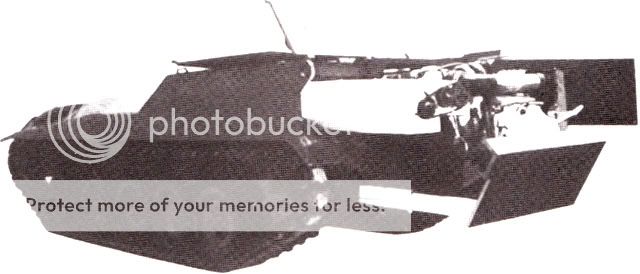
Powerpack of AAI RDF/LT slides out for ease of maintenance and field replacement
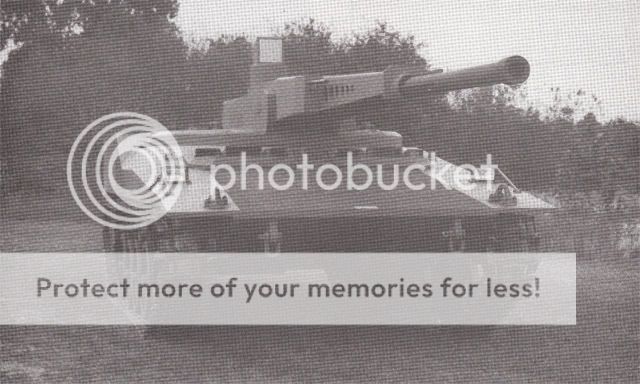
Prototype of AAI Rapid Deployment Force Light Tank
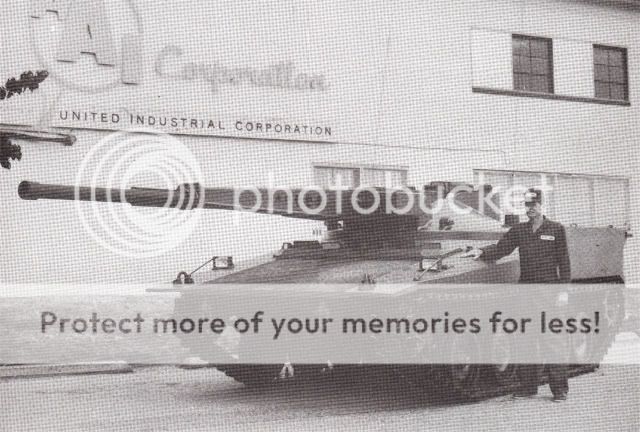
Rapid Deployment Force Light Tank fitted with Universal One-Man turret armed with 75 mm ARES gun
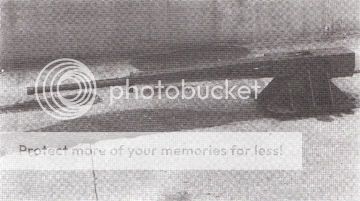
75 mm ARES automatic gun as fitted to the HSTV-L, RDF Light Tank and the High Mobility Agility Test Vehicle (HIMAG)
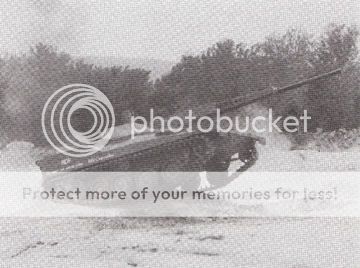
AAI Rapid Deployment Force Light Tank prototype fitted with new one-man all-cast turret armed with 75 mm ARES automatic gun undergoing trials in 1982
Last edited by a moderator:
- Joined
- 18 March 2008
- Messages
- 3,529
- Reaction score
- 978
13.2 Tonne Rapid Deployment Force Light Tank (RDF/LT)
Development
The original AAI Rapid Deployment Force Light Tank (RDF/T), described in the preceding entry, cannot be exported at present as the ARES 75 mm automatic cannon has not yet completed its US Army funded development.
In 1982 AAI announced that they had built the prototype of a 13.2 tonne RDF/LT fitted with a new two-man turret armed with the same 76 mm M32 gun as the M41 light tank’s. This was phased out of US Army service some years ago, although it remains in service with many other countries. The prototype uses the chassis of the original RDF/LT but production vehicles would have a slightly different hull and the description below relates to this. A Lockheed C-130H aircraft can carry two 13.2 tonne RDF/LTs.
Description
The hull of the RDF/LT is of all-welded aluminium construction. The driver is seated at the front of the hull on the left with 30 rounds of 76 mm ammunition stowed horizon¬tally to his right. The driver has a single-piece hatch cover that opens to the left, in the forward part of this are three periscopes the centre one of which can be replaced by a passive periscope for night driving.
The all-welded turret is in the centre of the vehicle with the commander seated on the left and the gunner on the right. Both have a single-piece hatch cover, six periscopes for all round observation and an M32 periscope for aiming the armament. The gunner’s M32 periscope incorporates a laser rangefinder.
Main armament consists of a 76 min high velocity M32 gun which is installed in the M41 tank. In addition to the range of ammunition originally developed for this weapon, and fully described in the entry for the M41 light tank, AAI have developed a new round of APFSDS-T ammunition based on their experience in developing ammunition for the ARES 75 mm automatic. This has already been tested in Denmark during trials with an M41 light tank. According to AAI, this projectile has three times the probability of killing a T-62 tank at a normal combat range of 1500 metres than the 105 mm M456 HEAT-T round and only slightly less kill probability at a similar range to the 105 men M735 APFSDS-T round. A 7.62 mm M240 machine gun is mounted coaxially with the main armament.
A Cadillac Gage stabilisation and weapons control system is fitted as standard enabling the vehicle to fire on the move with a high probability of a first round hit. Optional fire-control systems include an M32 sight with an AN/VSG-2 Tank Thermal Sight or a digital tank fire-control system with the AN/VSG-2 Tank Thermal Sight, AN/GVS-5 laser rangefinder and a digital ballistic computer.
The engine and transmission are mounted at the rear of the hull and the complete powerpack is on extensible rails to facilitate maintenance in the field.
The torsion bar suspension consists of five dual rubber tyred road wheels with the drive sprocket at the rear, idler at the front and one return roller which is positioned above the second and third roadwheel stations. Track is the M113.
SPECIFICATIONS
CREW 3
WEIGHT (combat) 13 200 kg (unloaded) 11 800 kg
POWER TO WEIGHT RATIO 26.5 hp/tonne
GROUND PRESSURE 0.48 kg/cm2
LENGTH GUN FORWARDS 7.34 m
LENGTH HULL 5.569 m
WIDTH 2.54 m
HEIGHT (overall, M32 sight) 2.235 m (hull top) 1.562 m
GROUND CLEARANCE 0.50 m
MAX ROAD SPEED 64 km/h
FUEL CAPACITY 378 litres
MAX CRUISING RANGE 500 km
FORDING 1 m
GRADIENT 60%
ENGINE General Motors 6V-53T, turbo-charged, 6-cylinder diesel developing 350 hp
TRANSMISSION General Motors, Allison Division, X-200 crossdrive, automatic
SUSPENSION torsion bar
ELECTRICAL SYSTEM 24 V
BATTERIES 6 × 12 V, 190 Ah
ARMAMENT (main) 1 × 76 mm (coaxial) 1 × 7.62 mm MG
AMMUNITION (main) 50 (coaxial) 2600
FIRE-CONTROL
turret power control hydraulic/manual
by commander yes
by gunner yes
GUN ELEVATION/DEPRESSION +22°/-10°
TURRET TRAVERSE 360°
Status: Prototype.
Manufacturer: AAI Corporation, Box 6767, Baltimore, Maryland 21204, USA.

Prototype of AAI 13.2 tonne Rapid Deployment Force Light Tank undergoing initial cross-country trials in 1982

AAI 13.2 tonne Rapid Deployment Force Light Tank prototype showing new turret armed with 76 mm M32 gun which can fire a new APFSDS-T projectile developed by AAI

Cutaway drawing of 13.2 tonne Rapid Deployment Force Light Tank showing crew positions and ammunition stowage
Development
The original AAI Rapid Deployment Force Light Tank (RDF/T), described in the preceding entry, cannot be exported at present as the ARES 75 mm automatic cannon has not yet completed its US Army funded development.
In 1982 AAI announced that they had built the prototype of a 13.2 tonne RDF/LT fitted with a new two-man turret armed with the same 76 mm M32 gun as the M41 light tank’s. This was phased out of US Army service some years ago, although it remains in service with many other countries. The prototype uses the chassis of the original RDF/LT but production vehicles would have a slightly different hull and the description below relates to this. A Lockheed C-130H aircraft can carry two 13.2 tonne RDF/LTs.
Description
The hull of the RDF/LT is of all-welded aluminium construction. The driver is seated at the front of the hull on the left with 30 rounds of 76 mm ammunition stowed horizon¬tally to his right. The driver has a single-piece hatch cover that opens to the left, in the forward part of this are three periscopes the centre one of which can be replaced by a passive periscope for night driving.
The all-welded turret is in the centre of the vehicle with the commander seated on the left and the gunner on the right. Both have a single-piece hatch cover, six periscopes for all round observation and an M32 periscope for aiming the armament. The gunner’s M32 periscope incorporates a laser rangefinder.
Main armament consists of a 76 min high velocity M32 gun which is installed in the M41 tank. In addition to the range of ammunition originally developed for this weapon, and fully described in the entry for the M41 light tank, AAI have developed a new round of APFSDS-T ammunition based on their experience in developing ammunition for the ARES 75 mm automatic. This has already been tested in Denmark during trials with an M41 light tank. According to AAI, this projectile has three times the probability of killing a T-62 tank at a normal combat range of 1500 metres than the 105 mm M456 HEAT-T round and only slightly less kill probability at a similar range to the 105 men M735 APFSDS-T round. A 7.62 mm M240 machine gun is mounted coaxially with the main armament.
A Cadillac Gage stabilisation and weapons control system is fitted as standard enabling the vehicle to fire on the move with a high probability of a first round hit. Optional fire-control systems include an M32 sight with an AN/VSG-2 Tank Thermal Sight or a digital tank fire-control system with the AN/VSG-2 Tank Thermal Sight, AN/GVS-5 laser rangefinder and a digital ballistic computer.
The engine and transmission are mounted at the rear of the hull and the complete powerpack is on extensible rails to facilitate maintenance in the field.
The torsion bar suspension consists of five dual rubber tyred road wheels with the drive sprocket at the rear, idler at the front and one return roller which is positioned above the second and third roadwheel stations. Track is the M113.
SPECIFICATIONS
CREW 3
WEIGHT (combat) 13 200 kg (unloaded) 11 800 kg
POWER TO WEIGHT RATIO 26.5 hp/tonne
GROUND PRESSURE 0.48 kg/cm2
LENGTH GUN FORWARDS 7.34 m
LENGTH HULL 5.569 m
WIDTH 2.54 m
HEIGHT (overall, M32 sight) 2.235 m (hull top) 1.562 m
GROUND CLEARANCE 0.50 m
MAX ROAD SPEED 64 km/h
FUEL CAPACITY 378 litres
MAX CRUISING RANGE 500 km
FORDING 1 m
GRADIENT 60%
ENGINE General Motors 6V-53T, turbo-charged, 6-cylinder diesel developing 350 hp
TRANSMISSION General Motors, Allison Division, X-200 crossdrive, automatic
SUSPENSION torsion bar
ELECTRICAL SYSTEM 24 V
BATTERIES 6 × 12 V, 190 Ah
ARMAMENT (main) 1 × 76 mm (coaxial) 1 × 7.62 mm MG
AMMUNITION (main) 50 (coaxial) 2600
FIRE-CONTROL
turret power control hydraulic/manual
by commander yes
by gunner yes
GUN ELEVATION/DEPRESSION +22°/-10°
TURRET TRAVERSE 360°
Status: Prototype.
Manufacturer: AAI Corporation, Box 6767, Baltimore, Maryland 21204, USA.
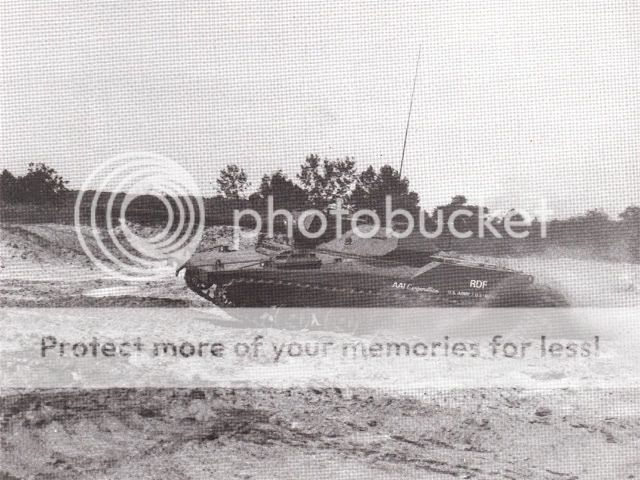
Prototype of AAI 13.2 tonne Rapid Deployment Force Light Tank undergoing initial cross-country trials in 1982
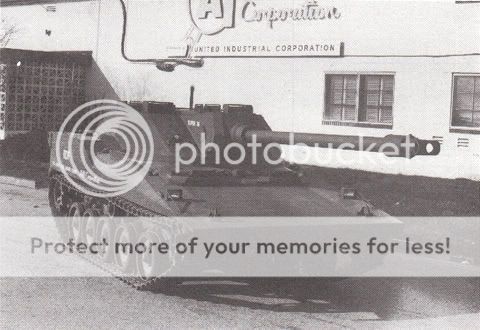
AAI 13.2 tonne Rapid Deployment Force Light Tank prototype showing new turret armed with 76 mm M32 gun which can fire a new APFSDS-T projectile developed by AAI
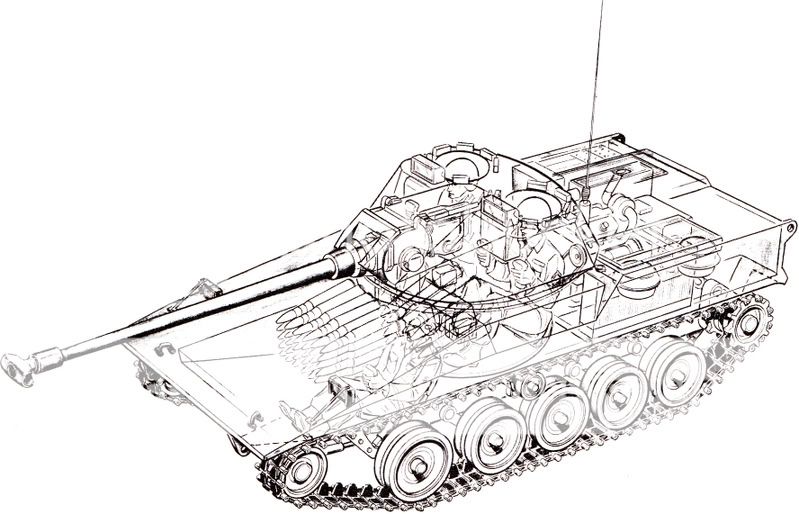
Cutaway drawing of 13.2 tonne Rapid Deployment Force Light Tank showing crew positions and ammunition stowage
- Joined
- 18 March 2008
- Messages
- 3,529
- Reaction score
- 978
Mobile Protected Gun System (MPGS)
The United States Marine Corps has a requirement for a highly mobile armoured vehicle which is at present called the Mobile Protected Weapons System (MPWS). It will be an additional anti-armour, anti-material, anti-personnel system complementing, at times replacing (with fewer capabilities) the MBT in combat operations during an amphibious assault and subsequent operations ashore at all levels of combat intensity.
As an integrated part of task organised units, the MPWS will operate with combined arms of infantry, artillery, air and MBTs, and be capable of operating over all types of terrain.
It should be able to deal with a wide variety of battlefield targets including tanks, ATGW carriers and ATGW ground mounts, light armoured vehicles, short-range artillery, motorised and dismounted troops, helicopters, anti-aircraft systems and fixed positions.
MPWS must be airportable in current transport aircraft such as the C-5A, C-130 and C-141, be able to ford rivers, be compatible with current amphibious craft and be fitted with an NBC system. Main armament could be the ARTS 75 mm automatic cannon (or a 90 mm version), or the 105 men Rheinmetall Rh 105-11 super low recoil gun already installed in the Swiss MOWAG Shark (8 X 8) vehicle or a lightweight 105 mm under development by Benet Laboratory.
In December 1981, the Marine Corps agreed to merge its MPWS Program with the Army’s Mobile Protected Gun System Program. The Army’s requirement is similar to that of the Marine Corps but did not require lift via the CH-53E helicopter. A draft Joint Service Operational Requirement has been developed and is being staffed at this time. The joint system would retain the Marine Corps helicopter lift requirement while incorporating many of the Army's tank-like characteristics.
Although fielding is projected for the early 1990’s, it is being reviewed in the context of various armor/anti-armor studies and considerations by the Army to restructure its light forces.
The United States Marine Corps has a requirement for a highly mobile armoured vehicle which is at present called the Mobile Protected Weapons System (MPWS). It will be an additional anti-armour, anti-material, anti-personnel system complementing, at times replacing (with fewer capabilities) the MBT in combat operations during an amphibious assault and subsequent operations ashore at all levels of combat intensity.
As an integrated part of task organised units, the MPWS will operate with combined arms of infantry, artillery, air and MBTs, and be capable of operating over all types of terrain.
It should be able to deal with a wide variety of battlefield targets including tanks, ATGW carriers and ATGW ground mounts, light armoured vehicles, short-range artillery, motorised and dismounted troops, helicopters, anti-aircraft systems and fixed positions.
MPWS must be airportable in current transport aircraft such as the C-5A, C-130 and C-141, be able to ford rivers, be compatible with current amphibious craft and be fitted with an NBC system. Main armament could be the ARTS 75 mm automatic cannon (or a 90 mm version), or the 105 men Rheinmetall Rh 105-11 super low recoil gun already installed in the Swiss MOWAG Shark (8 X 8) vehicle or a lightweight 105 mm under development by Benet Laboratory.
In December 1981, the Marine Corps agreed to merge its MPWS Program with the Army’s Mobile Protected Gun System Program. The Army’s requirement is similar to that of the Marine Corps but did not require lift via the CH-53E helicopter. A draft Joint Service Operational Requirement has been developed and is being staffed at this time. The joint system would retain the Marine Corps helicopter lift requirement while incorporating many of the Army's tank-like characteristics.
Although fielding is projected for the early 1990’s, it is being reviewed in the context of various armor/anti-armor studies and considerations by the Army to restructure its light forces.
Pyrrhic victory
This is going to hurt
- Joined
- 31 January 2008
- Messages
- 75
- Reaction score
- 83
isn't it the T-162 prototype of 175mm SPH behind it ? ???Pyrrhic victory said:What it looks like nowadays...
http://kr.blog.yahoo.com/shinecommerce/MYBLOG/yblog.html?fid=0&m=lc&sk=0&sv=RDF%2FLT
- Joined
- 18 March 2008
- Messages
- 3,529
- Reaction score
- 978
cador said:isn't it the T-162 prototype of 175mm SPH behind it ? ???
The cab looks like a standard M55 cab and the barrel looks like a 155mm. Though it looks longer than the howitzer length on the M55 (that terminated at the driving lock). So it might be an M53 prototype that was to be a 155mm gun version of the M52/M55 family of SP artillery. The T162 had a very long barrel.
Colonial-Marine
UAVs are now friend, drones are the real enemy.
- Joined
- 5 October 2009
- Messages
- 1,470
- Reaction score
- 1,323
Abraham Gubler said:Mobile Protected Gun System (MPGS)
In December 1981, the Marine Corps agreed to merge its MPWS Program with the Army’s Mobile Protected Gun System Program. The Army’s requirement is similar to that of the Marine Corps but did not require lift via the CH-53E helicopter. A draft Joint Service Operational Requirement has been developed and is being staffed at this time. The joint system would retain the Marine Corps helicopter lift requirement while incorporating many of the Army's tank-like characteristics.
Although fielding is projected for the early 1990’s, it is being reviewed in the context of various armor/anti-armor studies and considerations by the Army to restructure its light forces.
Is there any information on other proposals submitted during this MPGS program? I recall reading about an "XM4" which was referred to as the MPGS and several other names during the programs life. It was based on the Bradley hull and armed with a 105mm M68, but I have never been able to dig anything up on the program outside of one book. I've heard one rumor however that the low profile turret used on the M1128 is the same as that developed for this XM4.
DanielStarseer
ACCESS: Confidential
- Joined
- 17 January 2010
- Messages
- 70
- Reaction score
- 54
I always did admire these light tanks.
Thing I still can't figure is,
what...."individual" thought to suggest that,
at 13tons empty weight,
two of these could be flown intratheater in a C-130 (pre-J-Herc days, mind you!).
Keep in mind that even the latest C-130J would find it a hard struggle to get airborne in any reasonable field length
with a 26 ton cargo (does that include the chains, lashings, and binders to anchor the tanks securely into the aircraft?),
so I seriously doubt that any earlier C-130 types would get airborne carrying two of these....
Even with reduced fuel at take off (and thus requiring inflight refuel to get to any worthwhile range),
I still am pretty certain that 26tons exceeds any waiverable C-130 cargo limitations....
....Anyone?
(personally I think that line drawing depicting it is,...optimistic, to say the least.)
Thing I still can't figure is,
what...."individual" thought to suggest that,
at 13tons empty weight,
two of these could be flown intratheater in a C-130 (pre-J-Herc days, mind you!).
Keep in mind that even the latest C-130J would find it a hard struggle to get airborne in any reasonable field length
with a 26 ton cargo (does that include the chains, lashings, and binders to anchor the tanks securely into the aircraft?),
so I seriously doubt that any earlier C-130 types would get airborne carrying two of these....
Even with reduced fuel at take off (and thus requiring inflight refuel to get to any worthwhile range),
I still am pretty certain that 26tons exceeds any waiverable C-130 cargo limitations....
....Anyone?
(personally I think that line drawing depicting it is,...optimistic, to say the least.)
- Joined
- 9 October 2009
- Messages
- 21,973
- Reaction score
- 13,624
jsport
what do you know about surfing Major? you're from-
- Joined
- 27 July 2011
- Messages
- 7,732
- Reaction score
- 5,751
Reveals how the Abrams one shot 120mm was a inferior compromise compared to the RDF tank 90mm HV auto with its superior direct fire successful engagement capability and the MBT-70 152mm gun/launcher w/ its potential to have evolved to an indirect fire engagement capability. The two tanks that should have been.
Colonial-Marine
UAVs are now friend, drones are the real enemy.
- Joined
- 5 October 2009
- Messages
- 1,470
- Reaction score
- 1,323
I don't think the Abrams 120mm was an inferior compromise, the 120mm is just the gun that it should have featured from the start of series M1 production.
A RDF light tank with 75mm or 90mm (did that get to the prototype phase?) CT gun would have provided a useful capability if fielded and might have resulted in no need for the later M8 AGS with its 105mm gun. Yet relying on anything short of the 120mm gun to punch through the armor of later model T-72s and T-80s is not very good odds.
With enough work the medium velocity 152mm gun/missile launcher on the MBT-70 could have become a good weapon system, but would it really offer that much over the high velocity 120mm? The fire control systems introduced at around that time gave high probability of a first round hit. The extended ranges at which the Shillelagh might be a better choice weren't all that common on the potential West German battlefield. Even in the deserts of Iraq the Abrams was usually able to take out what it could see.
I'd say that starting in the 1990s with better optics and thermals that gun-launched ATGM capability becomes more useful and the possibility of B-LOS capability beings to emerge. So maybe then something like the medium velocity 152mm gun/missile launcher would be an ideal tank gun. However APFSDS had become the tank ammo of choice for dealing with heavily armored targets with composite armor, which is why the US was looking at that huge high velocity 140mm smoothbore for dealing with the next generation of Soviet armor.
It would have and is entirely possible to have gun-launched ATGMs from the 120mm smoothbore and even the old rifled 105mm but for the US Army those programs keep falling victim to the budget gods and questions of their practicality.
A RDF light tank with 75mm or 90mm (did that get to the prototype phase?) CT gun would have provided a useful capability if fielded and might have resulted in no need for the later M8 AGS with its 105mm gun. Yet relying on anything short of the 120mm gun to punch through the armor of later model T-72s and T-80s is not very good odds.
With enough work the medium velocity 152mm gun/missile launcher on the MBT-70 could have become a good weapon system, but would it really offer that much over the high velocity 120mm? The fire control systems introduced at around that time gave high probability of a first round hit. The extended ranges at which the Shillelagh might be a better choice weren't all that common on the potential West German battlefield. Even in the deserts of Iraq the Abrams was usually able to take out what it could see.
I'd say that starting in the 1990s with better optics and thermals that gun-launched ATGM capability becomes more useful and the possibility of B-LOS capability beings to emerge. So maybe then something like the medium velocity 152mm gun/missile launcher would be an ideal tank gun. However APFSDS had become the tank ammo of choice for dealing with heavily armored targets with composite armor, which is why the US was looking at that huge high velocity 140mm smoothbore for dealing with the next generation of Soviet armor.
It would have and is entirely possible to have gun-launched ATGMs from the 120mm smoothbore and even the old rifled 105mm but for the US Army those programs keep falling victim to the budget gods and questions of their practicality.
jsport
what do you know about surfing Major? you're from-
- Joined
- 27 July 2011
- Messages
- 7,732
- Reaction score
- 5,751
I don't think the Abrams 120mm was an inferior compromise, the 120mm is just the gun that it should have featured from the start of series M1 production.
A RDF light tank with 75mm or 90mm (did that get to the prototype phase?) CT gun would have provided a useful capability if fielded and might have resulted in no need for the later M8 AGS with its 105mm gun. Yet relying on anything short of the 120mm gun to punch through the armor of later model T-72s and T-80s is not very good odds.
We will never know what a 90mm HV w/DS, if developed, would have been capable of. Your proclaiming then is... but we do know, from the interview, the higher likelihood of hit w/ 3rd bursts especially against moving targets. Of course that accuracy would only be enhanced by now.
As stated the point of missile would be indirect fire.. Shillelagh would have been step toward near indirect fire top attack EFP missile such as Ford's Topkick missile. 152mm direct fire certainly could outperform 120mm, potential tandem or triple EFP to defeat reactive armor.With enough work the medium velocity 152mm gun/missile launcher on the MBT-70 could have become a good weapon system, but would it really offer that much over the high velocity 120mm? The fire control systems introduced at around that time gave high probability of a first round hit. The extended ranges at which the Shillelagh might be a better choice weren't all that common on the potential West German battlefield. Even in the deserts of Iraq the Abrams was usually able to take out what it could see.
in the emerging era of ramjets and energetics, the larger the rd the more burn and thus range.It would have and is entirely possible to have gun-launched ATGMs from the 120mm smoothbore and even the old rifled 105mm but for the US Army those programs keep falling victim to the budget gods and questions of their practicality.
- Joined
- 26 January 2011
- Messages
- 2,226
- Reaction score
- 645
I don't think the Abrams 120mm was an inferior compromise, the 120mm is just the gun that it should have featured from the start of series M1 production.
A RDF light tank with 75mm or 90mm (did that get to the prototype phase?) CT gun would have provided a useful capability if fielded and might have resulted in no need for the later M8 AGS with its 105mm gun. Yet relying on anything short of the 120mm gun to punch through the armor of later model T-72s and T-80s is not very good odds.
We will never know what a 90mm HV w/DS, if developed, would have been capable of. Your proclaiming then is... but we do know, from the interview, the higher likelihood of hit w/ 3rd bursts especially against moving targets. Of course that accuracy would only be enhanced by now.
As stated the point of missile would be indirect fire.. Shillelagh would have been step toward near indirect fire top attack EFP missile such as Ford's Topkick missile. 152mm direct fire certainly could outperform 120mm, potential tandem or triple EFP to defeat reactive armor.With enough work the medium velocity 152mm gun/missile launcher on the MBT-70 could have become a good weapon system, but would it really offer that much over the high velocity 120mm? The fire control systems introduced at around that time gave high probability of a first round hit. The extended ranges at which the Shillelagh might be a better choice weren't all that common on the potential West German battlefield. Even in the deserts of Iraq the Abrams was usually able to take out what it could see.
in the emerging era of ramjets and energetics, the larger the rd the more burn and thus range.It would have and is entirely possible to have gun-launched ATGMs from the 120mm smoothbore and even the old rifled 105mm but for the US Army those programs keep falling victim to the budget gods and questions of their practicality.
The more subject to atmospheric conditions. Ramject driven gun rounds are inherently less accurate than normal rounds. The crosswinds outside the gun tube affect them and the result is much wider dispersion. Ramjets rob the round of explosive filling and hence power.
It isn't. The gun-launcher was a PoS, it wasn't uncommon that you are either going to fire only ATGMs or only rounds due to how badly the system was designed (just firing one round of cannon ammunition is more than enough to damage the ATGM firing system to the point of combat ineffectiveness). The moment that the 105 got APFSDS ammunition that was actually practical, pretty much everyone in NATO abandoned the gun/launcher concept. Only the Russians and Israelis had any success with the concept.Reveals how the Abrams one shot 120mm was a inferior compromise compared to the RDF tank 90mm HV auto with its superior direct fire successful engagement capability and the MBT-70 152mm gun/launcher w/ its potential to have evolved to an indirect fire engagement capability. The two tanks that should have been.
Right now, we're at the end of cordite-based propellants (so to speak) and thus unable to get more oomph out of our guns. The Chinese had to increase the caliber and massively increase the case size just to get a conventional (i.e. something from the cordite 'tree') propellant to fling an APFSDS round at Mach 5. The only other way to increase the lethality of a gun is via upping the size and thus weight... which is considered the method of last resort for pretty much everyone.
Electrothermal Chemical guns are still decades away from implementation, so the only real way forward is upping the gun size...
Kat Tsun
eeeeeeeeeeeeeee
- Joined
- 16 June 2013
- Messages
- 1,371
- Reaction score
- 1,778
Energy issues aside I'm pretty electrothermal chemical guns were just intensely mediocre and offered nowhere near the ME they promised. Lightning Bolt only got something like an 8% or 9% increase in ME over 120mm M256, and IIRC that was pretty much entirely due to its ignition method compensating for temperature and timing variances in conventional primers.
Seems about as dead end a technology as hypervelocity APCR light gas guns, really.
Seems about as dead end a technology as hypervelocity APCR light gas guns, really.
jsport
what do you know about surfing Major? you're from-
- Joined
- 27 July 2011
- Messages
- 7,732
- Reaction score
- 5,751
Once again getting back to thread. Some cant seem to do. below are renders of a possible updated HSTV-L.
This is player-created content for the game Space Engineers.
Steam Workshop::HSTV-L [1:1 Replica by bruh3]
Not really, but then again you're ignoring the fact that electro/plasma ignition is going to up the muzzle velocity to 2km/s from what I understand (with a 'celling' MV of 4km/s), where 'conventional' propellants can't even top over 1.8km/s on a good day.Energy issues aside I'm pretty electrothermal chemical guns were just intensely mediocre and offered nowhere near the ME they promised. Lightning Bolt only got something like an 8% or 9% increase in ME over 120mm M256, and IIRC that was pretty much entirely due to its ignition method compensating for temperature and timing variances in conventional primers.
Seems about as dead end a technology as hypervelocity APCR light gas guns, really.
Note, this is basically generation 1 guns.
Kat Tsun
eeeeeeeeeeeeeee
- Joined
- 16 June 2013
- Messages
- 1,371
- Reaction score
- 1,778
Lightning Bolt saw an improvement of about 8% in muzzle velocity in the best possible case (cold ammo) firing M829A2 ammunition. It was closer to 3-4% improvements in muzzle velocity, at temperate ambients, and the advantage closed to basically nothing in high ambient storage temperatures. Newer propellants will shrink this further in the conventionally ignited round's favor.
I'm also pretty sure a penetrator that isn't maraging steel would suffer from velocities over 2 km/s. 1,800 m/s is adequate for any modern penetrator design or material.
It might even be a bit too fast, really, as the optimal velocities for DU and WHA tend to hover around 1,600 and 1,700 m/s respectively (plus or minus about 20 mm of boiler plate), which is where most rounds aim for. They can certainly go faster than that, by making rounds lighter, or propellant loads hotter, but it isn't really done, because you lose performance against armor at higher speeds unless you're using steel or something (and steel isn't great).
ETC currently offers nothing except a more stable temperature-velocity curve and more consistent charge ignition timing, due to its method of ignition (electrical plasma igniter versus black powder), which are fine, but it's certainly not a serious candidate for cracking futuristic tank armors. The advantages of ETC (=>50% increases in muzzle energy) simply never materialized despite years of tests. Making a bigger gun seems to be a genuinely faster method of increasing performance against future tanks. Given that MGCS is going to be fielded sometime in the next 20 years, well that's a pretty powerful statement by Rheinmetall.
That said, I suspect that it's really a combination of ETC needing higher pressure guns (i.e. more propellant) to throw heavier (slower) projectiles, to keep the penetrator within the optimal velocity band, that made Rheinmetall do this. It's easier to make a same pressure, bigger bore gun, than it is to make a higher pressure, same bore one.
I'm also pretty sure a penetrator that isn't maraging steel would suffer from velocities over 2 km/s. 1,800 m/s is adequate for any modern penetrator design or material.
It might even be a bit too fast, really, as the optimal velocities for DU and WHA tend to hover around 1,600 and 1,700 m/s respectively (plus or minus about 20 mm of boiler plate), which is where most rounds aim for. They can certainly go faster than that, by making rounds lighter, or propellant loads hotter, but it isn't really done, because you lose performance against armor at higher speeds unless you're using steel or something (and steel isn't great).
ETC currently offers nothing except a more stable temperature-velocity curve and more consistent charge ignition timing, due to its method of ignition (electrical plasma igniter versus black powder), which are fine, but it's certainly not a serious candidate for cracking futuristic tank armors. The advantages of ETC (=>50% increases in muzzle energy) simply never materialized despite years of tests. Making a bigger gun seems to be a genuinely faster method of increasing performance against future tanks. Given that MGCS is going to be fielded sometime in the next 20 years, well that's a pretty powerful statement by Rheinmetall.
That said, I suspect that it's really a combination of ETC needing higher pressure guns (i.e. more propellant) to throw heavier (slower) projectiles, to keep the penetrator within the optimal velocity band, that made Rheinmetall do this. It's easier to make a same pressure, bigger bore gun, than it is to make a higher pressure, same bore one.
Last edited:
jsport
what do you know about surfing Major? you're from-
- Joined
- 27 July 2011
- Messages
- 7,732
- Reaction score
- 5,751
And your point is what again? The render is still a futuristic concept.Once again getting back to thread. Some cant seem to do. below are renders of a possible updated HSTV-L.
This is player-created content for the game Space Engineers.

Steam Workshop::HSTV-L [1:1 Replica by bruh3]
steamcommunity.com
jsport
what do you know about surfing Major? you're from-
- Joined
- 27 July 2011
- Messages
- 7,732
- Reaction score
- 5,751
..or not as it is not a formal proposal. Contributors welcomed.. personal piling comments...Thank you drejr. Sources should always be provided.
jsport
what do you know about surfing Major? you're from-
- Joined
- 27 July 2011
- Messages
- 7,732
- Reaction score
- 5,751
KT never even read the entire PDF, so why argue w/ ignorance?Not really, but then again you're ignoring the fact that electro/plasma ignition is going to up the muzzle velocity to 2km/s from what I understand (with a 'celling' MV of 4km/s), where 'conventional' propellants can't even top over 1.8km/s on a good day.Energy issues aside I'm pretty electrothermal chemical guns were just intensely mediocre and offered nowhere near the ME they promised. Lightning Bolt only got something like an 8% or 9% increase in ME over 120mm M256, and IIRC that was pretty much entirely due to its ignition method compensating for temperature and timing variances in conventional primers.
Seems about as dead end a technology as hypervelocity APCR light gas guns, really.
Note, this is basically generation 1 guns.
- Joined
- 6 November 2010
- Messages
- 5,262
- Reaction score
- 5,514
You should always provide sources..or not as it is not a formal proposal. Contributors welcomed.. personal piling comments...Thank you drejr. Sources should always be provided.
- so readers can judge the credibility of material
- so SPF staff can judge whether copyright is infringed
From Forum Rules:
Give your sources. This is vital to allow other forum members to judge your contribution appropriately and to appropriately credit the original source.
Similar threads
-
-
-
-
-
Army Wants 'Air Droppable' Light Tank & Ultra-Light Vehicles
- Started by bobbymike
- Replies: 740

